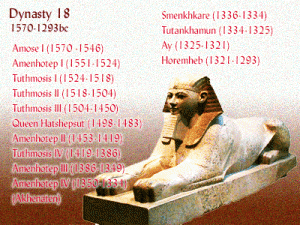Ancient Egypt Aye and Horemheb Facts Aye and Horemheb were respectively second last and last ruler of the 18th Dynasty of Ancient Egypt. they were among the most controversial ruler of that time. There are many myths surrounding the Origin and Accession of these two rulers. Pharaoh AyeAye was the second last ruler of 18th dynasty but he was not the son of previous Pharaoh. Aye was an important official during the reign of Akhenaten. It was after the death of Pharoah Tutankhamen that Aye came to the throne and reigned for some 4 years. As a King, Aye’s first duties was to bury Tutankhamen. In tutankhamen’s tomb, Aye is shown performing the Opening of the Mouth ceremony for Osiris Nebkheperre Tutankhamen  Aye married Tutankhamen’s widow Ankhesenamun to gain the throne. Pharoah Aye was 70 years when he ascended the throne. He died after ruling for a short period of 4 years. Aye was buried in KV23 in the King’s Valley. KV23 is sometimes referred to as WV23 because it is located in the West Valley. Horemheb destroyed Aye’s tomb when he ascended the throne. There are controversies surrounding the accession of Aye as Pharaoh. It is argued by scholars that he killed young Tutankhamun to gain the throne. He did indeed marry Ankhesenamun but she vanished from historical records. This suggests that Aye just used her to gain the throne. Pharaoh Horemheb
Horemheb is a well-known general in the army from the time of famous Pharaoh Tutankhamen. Horemheb started his career under Akhenaten. Ancient Egyptian King Amenhotep III (1389 BC -1351 BC) reigned from the capital at Thebes. Towards the end of the reign of Amenhotep III, Horemheb came to prominence as a soldier, statesman, and diplomat. Horemheb served Akhenaten the heretic King who renounced the old religion and moved everyone from Thebes to his new city of Amarna dedicated to the new and only god, the Aten. Horemheb held the position of Commander-in-chief in Akhenaten’s army. Pharoah Aye died after his short reign of 4 years. Horemheb became the Pharaoh of Egypt after Aye’s death. Horemheb was the last and popular king of the eighteenth dynasty of the Ancient Egyptian Kings. Horenheb’s tomb in Saqarra is the source of information on him. Paatenemheb was a courtier in Akhenaten’s reign. It is speculated that he was none other than Horemheb. Paatenemheb prepared a tomb in the Amarna city (tomb 24) for himself. He had the titles King’s scribe, Steward of the Lord of the Two Lands, General of the Lord of the Two Lands. Horemheb is popular as he put an end to the chaos caused by the heretic King Akhenaten. He restored the established order in Egypt with his Great Edict or code of laws and eradicated all traces of the heretic religion. However, the Great Edict or the code of laws were harsh as they ensured that all grain and food was taxed and accounted for. Severe punishments for breaking the Great Edict laws included exile and even having the nose cut off. |
